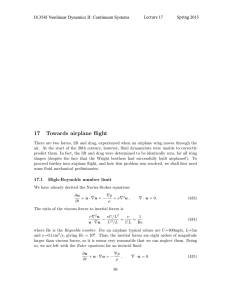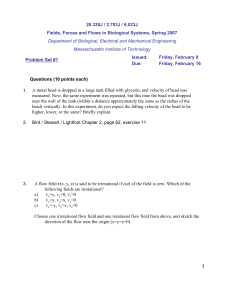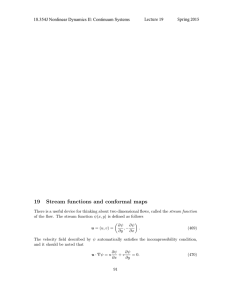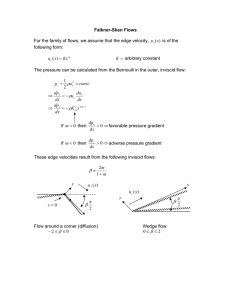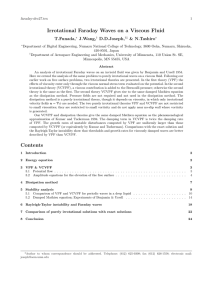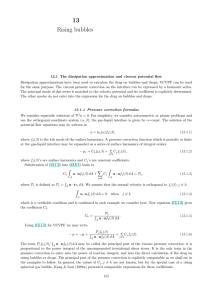CHAPTER 3. HIGH-SPEED FLOWS
advertisement
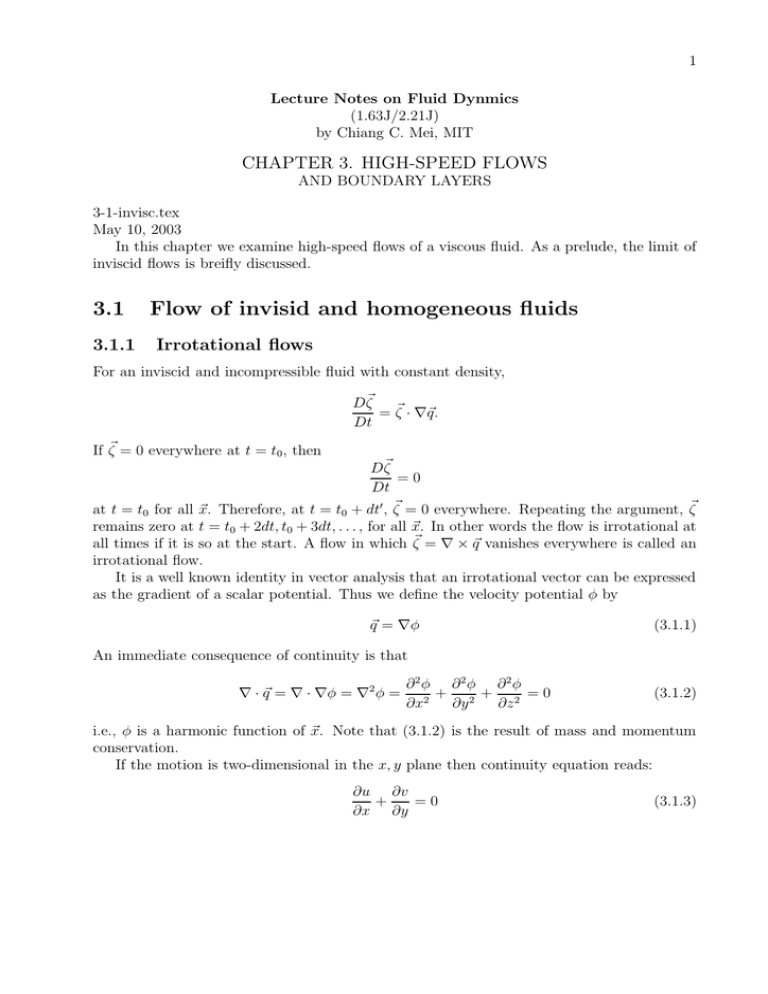
1 Lecture Notes on Fluid Dynmics (1.63J/2.21J) by Chiang C. Mei, MIT CHAPTER 3. HIGH-SPEED FLOWS AND BOUNDARY LAYERS 3-1-invisc.tex May 10, 2003 In this chapter we examine high-speed flows of a viscous fluid. As a prelude, the limit of inviscid flows is breifly discussed. 3.1 3.1.1 Flow of invisid and homogeneous fluids Irrotational flows For an inviscid and incompressible fluid with constant density, D ζ~ ~ = ζ · ∇~q. Dt If ζ~ = 0 everywhere at t = t0 , then D ζ~ =0 Dt at t = t0 for all ~x. Therefore, at t = t0 + dt0 , ζ~ = 0 everywhere. Repeating the argument, ζ~ remains zero at t = t0 + 2dt, t0 + 3dt, . . . , for all ~x. In other words the flow is irrotational at all times if it is so at the start. A flow in which ζ~ = ∇ × q~ vanishes everywhere is called an irrotational flow. It is a well known identity in vector analysis that an irrotational vector can be expressed as the gradient of a scalar potential. Thus we define the velocity potential φ by ~q = ∇φ (3.1.1) An immediate consequence of continuity is that ∇ · q~ = ∇ · ∇φ = ∇2 φ = ∂2φ ∂2φ ∂2φ + 2 + 2 =0 ∂x2 ∂y ∂z (3.1.2) i.e., φ is a harmonic function of ~x. Note that (3.1.2) is the result of mass and momentum conservation. If the motion is two-dimensional in the x, y plane then continuity equation reads: ∂u ∂v + =0 ∂x ∂y (3.1.3) 2 and irrotationality requires ∂v ∂u − =0 ∂x ∂y (3.1.4) These two equations are identical to the Cauchy-Riemann conditions relating the real and imaginary parts of an analytic function of the complex variable z = x + iy. The velocity components can be expressed as the gradient of a two-dimensional potential φ u= ∂φ ∂x v= ∂φ ∂y (3.1.5) which satifies the Laplace equation, ∂2φ ∂2φ + 2 =0 ∂x2 ∂y (3.1.6) It is also useful to introduce another scalar function, the stream function ψ, defined by u= ∂ψ ∂y v=− ∂ψ . ∂x (3.1.7) so that (3.1.3) is satisfied automatically. Substituting Eqn. (3.1.7) into Eqn. (3.1.4), we find ψ to be a harmonic function too. ∂2ψ ∂2ψ + 2 = 0. ∂x2 ∂y By definition, (u =) ∂φ ∂ψ = , ∂x ∂y (v =) ∂φ ∂ψ =− ∂y ∂x (3.1.8) (3.1.9) therefore φ and ψ also satisfy Cauchy-Riemann conditons and are harmonic conjugates of each other. This is why the theory of complex functions is an important tool in twodimensional potential flows. In the plane of x, y, lines of constant φ are called equipotential lines; the velocity vector is normal to equipotential lines and is directed from lower to higher poteitials. Lines of constant ψ are the streamlines; the velocity vector is tangential to the local streamline. It follows that equi-potentials are perpendicular to streamlines. As a formal proof we note that ∇φ · ∇ψ = φx ψx + φy ψy = u(−v) + vu = 0 (3.1.10) Indeed the difference of the stream functions at two points is just the volume flux rate between the two points. This can be seen by using the definitions (3.1.7). First ψ(x, y) has the dimension of volume flux rate : U L = L2 /T . With reference to Figure (??), the flux between two streamlines can be calculated in two equivalent ways uδy (along x = constant) = −vδx (along y = constant) 3 Figure 3.1.1: Definition of the stream function . Figure 3.1.2: Physical meaning of the stream function . In view of (3.1.7), u= ∂ψ δψ = | , ∂y δy x= const. hence uδy = δψ δy = δψ, ∂y v=− ∂ψ δψ =− | , ∂x ∂x y= const. − vδx = δψ δx = δψ. ∂x where δψ = ψ2 − ψ1 . simple observations will confirm that the stream funciton has all the features of the rate of volume flux. From the theory of complex functions, the following complex potential √ w = φ(x, y) + iψ(x, y) i = −1. (3.1.11) 4 is analytic in z = x+iy, except at singular points. In particular the derivative is independent of direction. Indeed, ∂w ∂w dw = = dz ∂x i∂y since ∂φ ∂ψ ∂w ∂φ ∂ψ ∂w = +i = u − iv, and = −i + = u − iv. ∂x ∂x ∂x i∂y ∂y ∂y Because of these connections to complex variables, the theory of analytical functions has been a powerful tool for solving 2D irrotational flow problems for a long time. Its luster has faded somewhat only after the advent of computers. 3.1.2 Bernoulli theorems of homogeneous fluids Unsteady and irrotational flows From the momentum equation, ~q 2 1 ∂~q +∇ − q~ × (∇ × ~q) = − ∇p + f~. ∂t 2 ρ (3.1.12) If the body force is conservative and the flow irrotational, i.e., f~ = −∇Γ and q~ = ∇φ, then " # ∂φ ~q 2 p ∇ + + +Γ =0 ∂t 2 ρ which can be integrated in space to give ∂φ ~q 2 p + + + Γ = C(t) ∂t 2 ρ (3.1.13) for all ~x. This Bernoulli law is useful in the theory of surface waves. Steady but rotational flows The momentum equation reads: 1 q~ · ∇~q = − ∇p + f~ ρ still applies. If ρ = constant and f~ = −∇Γ, we have qj ∂qi 1 ∂p ∂Γ =− − ∂xj ρ ∂xi ∂xi and, by scalar multiplication with qi , qi ∂qi qj ∂xj ! ∂ = qi ∂xi p − −Γ ρ ! 5 Now the left-hand side can be written as qj ∂ qi qj ∂xj 2 since ∂qj =0 ∂xj Therefore, ∂ qi ∂xi and " # q~ 2 p + + Γ = 0. 2 ρ q~ 2 p + + Γ = constant along a streamline. 2 ρ (3.1.14) A streamline is a curve along which the velocity vectors are tangent to the line. It is importatn that the constant may be different for different streamlines, hence (3.1.14) is different from (3.1.13). Most of the wave phenonmena in fliuds can be described by an inviscid theory. The interested reader should visit the website for WAVES: http://web.mit.edu/fluids-modules/waves/www/


